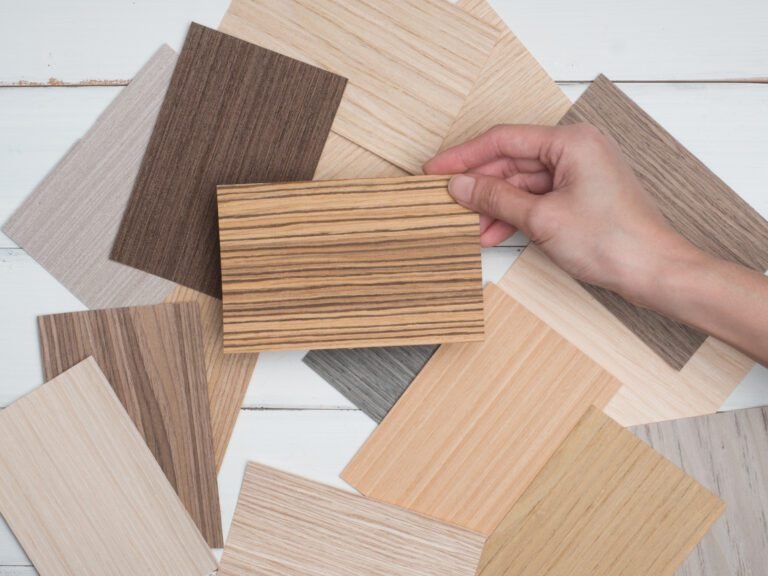Step into any flooring showroom and you’ll see gorgeous wood planks everywhere. Some are solid hardwood while others are engineered. Unless someone highlights the distinction, the two products look, for all intents and purposes, the same at face value. This is the whole intention behind the engineered construction; you get the appearance of real wood without some restrictions that natural hardwood presents.
However, while they may be two versions of the same thing, they are constructed completely differently, function differently in your home, and are more appropriate for certain situations for which the other one absolutely will not work. Knowing what’s special about each can prevent frustrating mistakes and ultimately help you choose a flooring option that works for your specific space.
How They’re Actually Constructed
Solid hardwood is easy to understand. You cut down a tree, mill it into planks and that’s your floor. There is no sublayer, and the average thickness – usually between 18-20mm, is one solid piece of oak, maple, walnut or whatever variety you choose. What you see on top is what you get all the way through to the bottom.
For engineered wood, however, that’s only half true. The top layer is hardwood, usually between 3-6mm thick, but below that lies a series of plies or high-density fiberboard that create a sublayer. These plies are crossed in grain direction like traditional plywood. This means that although the product is still real wood at the surface, by constructing it this way creates an entirely different product that will respond differently to situations.
This isn’t about cutting corners to create a cheaper version of hardwood (although it can be less expensive). It’s a solution to a problem solid wood creates in modern homes.
The Expansion Issue No One Cautions You About
Wood moves. Not excessively but enough to ruin your day if you don’t plan for it. As humidity changes over the year, be it summer or winter, solid hardwood expands in humid months and shrinks in dry ones. Take a room that’s 4m wide; that’s anywhere from 10-15mm of expansion over the course of 12 months. This means that solid wood must have expansion gaps around its perimeter and cannot be installed in certain fashions.
With engineered wood construction, the crossover of grain direction minimizes movement as much as possible. Those interlaying plies work against each other. Therefore, engineered flooring has some expansion space but not nearly as much as solid hardwood requires. Stabilized flooring allows for specific installations solid wood cannot attain.
Where Each Option Actually Works
Solid hardwood presents a variety of rules where it’s applicable to what subfloor. It should always sit on top of a wooden subfloor; ideally there should be a crawlspace/basement below it for airflow. If it’s installed directly over concrete, you’re asking for trouble; moisture will infiltrate from below and curl boards in time. Additionally, solid hardwood does not work with underfloor heating systems thanks to the constant fluctuation of heat and moisture affecting its movement.
Engineered floors have no issues in these areas; thanks to its stabilized construction, it can go directly over concrete slabs. It works fine with underfloor heating because it’s less reactive and less likely to move. In addition, engineered wood can go in basements (keeping an eye on humidity levels), and some engineered products are approved for areas like bathrooms and kitchens – rooms most hardwood professionals shy away from with solid wood.
Theoretically speaking, if you own a newer home built on a concrete subfloor, most homes constructed throughout the UK in the past few decades, then solid hardwood isn’t even an option unless you’re willing to build up a wooden subfloor first (at extra cost) which impacts ceiling height.
Installation Matters More Than You Think
With solid hardwood installation, you nail or staple it to a wooden subfloor. Each plank is mechanically fastened which is a part of why it needs that wooden base. You can glue solid wood down but this is less common due to the necessity of having specific conditions.
With engineered flooring, you have options. You can nail it down like solid wood. You can glue it down directly to concrete. Or you can float it which means the planks simply click together and sit on top of underlay without being connected to the underlayment at all. Floating installation is quicker, less permanent (you can take the flooring with you if you move), and requires no professional equipment with knowledgeable DIY. Engineered wood is stable enough to support floating; if solid wood was floated, its movement would wreck the installation.
The Refinishing Debate
Solid hardwood wins here since it’s solid wood construction from top to bottom means refinishing can happen repeatedly throughout its life. A floor that shows wear and tear can be refinished back to like-new condition. Depending on thickness, it may have up to 5-7 opportunities for this process in its lifespan.
With engineered floors, they too can be refinished – but only to a degree. Since it’s only real wood on the surface layer, its thickness determines how many times it can be sanded down. A 6mm wear layer can garner 2-3 refinishes; a 3mm layer may only allow for one sanding (if lucky). Once someone sands through that top layer, they’ve hit the ply core and the flooring must be replaced – very helpful information when homeowners choose lighter shades that may show scratches more readily or need to be considered sooner than later when they do.
That said, modern engineered floor finishes boast more toughness than what’s on solid hardwood; many engineered floors come with factory-applied UV-cured lacquers that protect better than site-finished options. So while they may not be able to be refinished as many times over, they may not need it as often.
Cost Differences That Aren’t What You Think
The common misconception is that engineered is always going to be cheaper than solid hardwoods. This is not necessarily true. Oftentimes engineered woods will be less expensive (though not always); for example an upper tier engineered wood with a thicker wear layer and European oak can cost as much or more than mid-range solid hardwoods at least for the materials; installation tends to be where costs differ.
Solid hardwood installation tends to be more expensive because of the equipment required and required expertise; you need nailers; someone who knows how to use them; additional time is needed for installation due to structural concerns versus engineered woods which boast click lock floating systems that competent DIYers can install with basic tools. Even if hired out for installation, floating systems are quicker, and therefore cheaper, than secured systems.
Additionally, prep work saves money when it comes to engineered woods; installing over concrete means solid hardwood may require framing a subfloor first from treated lumber joists which adds significant cost; engineered materials can go straight down without concern.
Which One Makes More Sense in Your Space?
Neither option is better than the other; they solve different problems. For example, if you live in an older home with wooden subfloors throughout, solid hardwood represents longevity with maximum refinishing capability. If you live in a newer home with concrete subfloors or underfloor heating or rooms with humidity issues, engineered construction handles those challenges best.
When it comes to appearance, and this should not matter, both options look like real wood; that’s because they are real wood at the surface level. When it comes to installation ease, this leans toward engineered construction especially if you’re working by yourself. When it comes to maintenance/replacement longevity this leans toward solid hardwood assuming your house permits such an installation.
Most importantly, know what you’re actually getting with either option before purchase; construction matters more than wood type or finish when determining whether this floor will work where you want it to work. Getting that part wrong means crooked boards and ruined installations, and expensive replacements regardless of how pretty it looked in the showroom.


































